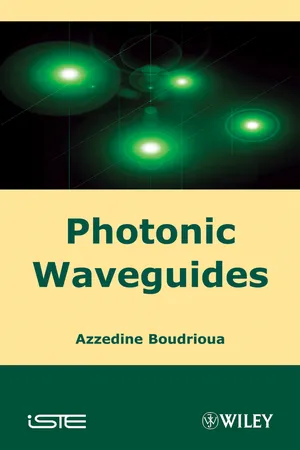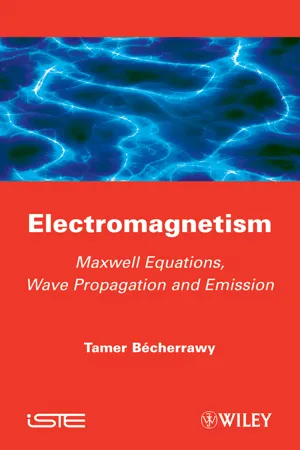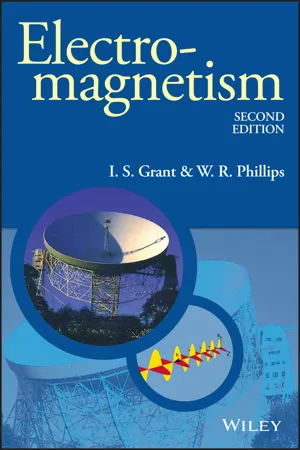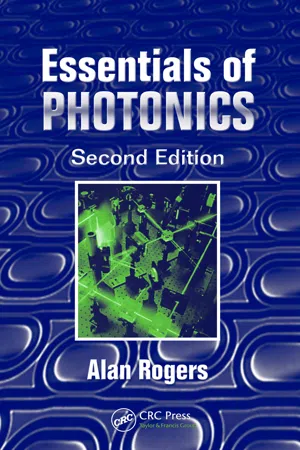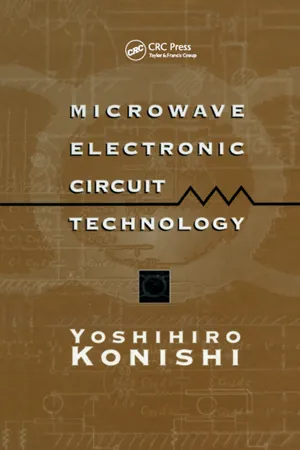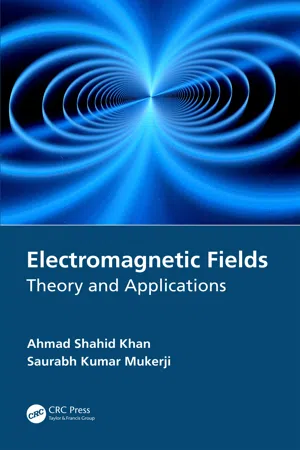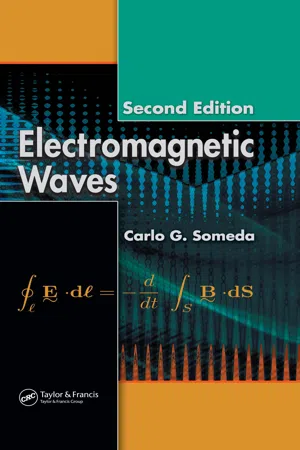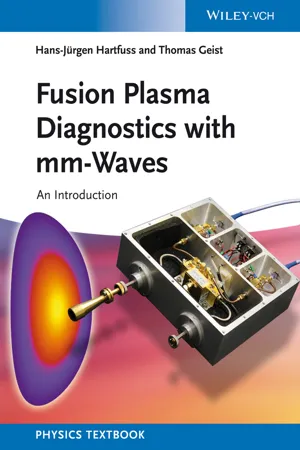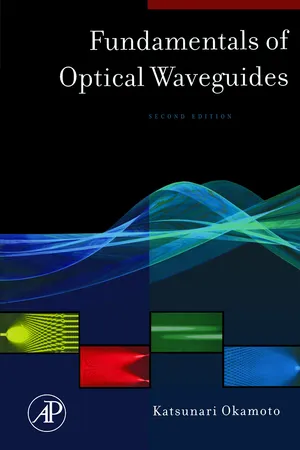Physics
Waveguide
A waveguide is a structure that guides electromagnetic waves, such as light or radio waves, along a specific path. It is typically used to confine and direct the propagation of waves, preventing them from spreading out in all directions. Waveguides are commonly used in various applications, including telecommunications, radar systems, and optical communication.
Written by Perlego with AI-assistance
Related key terms
Related key terms
1 of 4
Related key terms
1 of 3
11 Key excerpts on "Waveguide"
- eBook - ePub
Photonic Waveguides
Theory and Applications
- Azzedine Boudrioua(Author)
- 2013(Publication Date)
- Wiley-ISTE(Publisher)
Chapter 1Optical Waveguide Theory
Optical Waveguides are structures with three layers controlling light confinement and propagation in a well defined direction inside the central layer (Figure 1.1 ).Light confinement is carried out by successive total reflections on the two interface guides – substrate and guide – superstrate.Figure 1.1. Planar optical WaveguideLight propagation is governed by an interference phenomenon which occurs inside the guide between two waves; one of them undergoes two successive total reflections. For a better understanding of the guided wave propagation, we will recall the main principles of these two phenomena, total reflection and interference, inside a transparent plate with parallel faces.1.1. Principles of optics
1.1.1. Total reflection phenomenonLet us consider an interface separating two mediums 1 and 2, which are dielectric, lossless, homogenous and isotropic with refractive indices n1 and n2 , respectively. An electromagnetic wave propagates from 1 to 2 with an angle of incidence θi related to the normal of the interface (Figure 1.2 ).The electric field of the incident wave is given by:Figure 1.2. Reflection on an interface (medium 1/medium 2)[1.1][1.2]is the wave vector in the vacuum (λ: wavelength in the vacuum) and Ei0 is the incident wave amplitude. The electric fields of the reflected and transmitted waves can be written:[1.3][1.4]In addition, refraction law is given by:[1.5][1.6]In the case of n1 > n2 , there is an incident angleθl, as:[1.7]Forθi>θl, the incident wave is totally reflected into medium 1 (total reflection) and the angleθtof the transmitted wave is complex [Bor 1999, War 1988]:[1.8]From [1.4 ], the transmitted wave can be written as:[1.9]This wave propagates in the Oz direction with an amplitude exponentially decreasing in the Ox direction. This is called an evanescent wave. Also, according to Fresnel’s formulae, the considered wave undergoes a phase shift compared to the incident wave, given by [Bor 1999]: - eBook - ePub
Quantum Wells, Wires and Dots
Theoretical and Computational Physics of Semiconductor Nanostructures
- Paul Harrison, Alex Valavanis(Authors)
- 2016(Publication Date)
- Wiley(Publisher)
Chapter 13 Optical Waveguideswith C. A. EvansUniversity of Leeds13.1 Introduction to optical Waveguides
Optical Waveguides are an integral aspect of optoelectronic devices. Gaining the ability to direct the flow of light, just as copper wires and coaxial cable direct the flow of electrons, enabled a ‘quantum leap’ to be made in areas such as photonics and communications. Optoelectronic devices such as amplifiers, optical fibres, power splitters, reflectors, directional couplers, polarisers, modulators, converters and frequency shifters rely on the ability to guide light to where it is needed. Optical Waveguides also play a large role in the operation of semiconductor laser diodes. The gain medium is placed within a cavity, which is terminated at either end with partially reflecting mirrors. This configuration allows photons to travel back and forth along the cavity, causing more and more stimulated emission until the optical gain overcomes the absorption loss and lasing commences. This behaviour gives rises to standing wave patterns between the mirrors, which are known as longitudinal Waveguide modes (for more information on longitudinal modes, see [1]). The rate at which stimulated emission occurs from an excited state in a laser is directly proportional to the density of photons at the emission frequency in the laser cavity. To this end, it is beneficial to increase the density of photons, and this is done by confining the photons within the cavity using an optical Waveguide. An optical Waveguide therefore provides transverse light confinement, preventing beam divergence as it propagates along the cavity, which helps to maintain a high optical intensity and hence high gain along its entire length. A schematic representation of a typical laser Waveguide cavity is shown in Fig. 13.1 - eBook - ePub
Electromagnetism
Maxwell Equations, Wave Propagation and Emission
- Tamer Becherrawy(Author)
- 2013(Publication Date)
- Wiley-ISTE(Publisher)
For instance, the mode m of a Waveguide formed by two plane and parallel plates has a cut-off frequency m = mv /2 a. A wave of frequency may only propagate in the dominant mode if v /2 a < < v/a, i.e. a < λ < 2a, where λ = v/ is the wavelength in the infinite medium. Similarly, to transmit light in an optical fiber, its radius must be of the order of the micrometer. As the transverse dimensions of Waveguides are of the order of X, an important part of the wave is diffracted at its extremity and another part is reflected back. If the Waveguide ends in an antenna, the transmitted wave may be directed and the reflection is reduced at its end. One of the most important uses of Waveguides is to transmit signals and information. In order to only allow the dominant mode, the fields at the entry of the guide must be established in this mode configuration by using appropriate mode filters. We may transmit waves of frequency between several dozen kilohertz and a few hundred megahertz by coaxial cables formed by a wire surrounded by an insulating medium and a braided copper sheathing. This also protects the signal from the interference of other unwanted signals. In such a cable, the TEM wave of any frequency can propagate besides TM and TE waves if their frequency is higher that the cut-off frequency of the modes. Coaxial cables are used, for instance, to connect the parabolic antenna to a television set and the amplifier of a radar system to its antenna. In telephony, a bundle of some 20 cables of this type allows more than 1.3 x 10 5 simultaneous telephone calls to be transmitted. At hyper-frequencies (several gigahertz), we may use the TE or TM modes if the TEM can be eliminated. This can be achieved with a rectangular or cylindrical single-conductor Waveguide. For instance, a circular Waveguide of 5 cm has a useful bandwidth of several gigahertz near 40 GHz - eBook - ePub
- I. S. Grant, W. R. Phillips(Authors)
- 2013(Publication Date)
- Wiley(Publisher)
Since guides are rarely used in any but the TE 01 mode this is usually of little practical importance. Dispersion in the TE 01 mode can influence the time structure of pulses of radiation sent down a guide. The pulse corresponds to a group of waves in a band of frequencies, and the low frequencies in the group travel down the guide slower than the high frequencies. This results, as is usual in dispersive situations, in the pulse spreading out in time as it proceeds down the guide. Waveguides with circular cross-sections are used in special applications, such as transmission of circularly polarized waves. The solutions of the wave equation which obey the boundary conditions at the walls again correspond to TE and TM modes characterized by integers m and n. The mathematical description of the modes is more complex than for rectangular Waveguides and we will not go into it here. Optical fibres provide an interesting example of the transmission of electromagnetic waves down circular Waveguides. An optical fibre is a thin thread of transparent dielectric, with diameter usually of a few up to a few hundred microns, enclosed in a cladding of material of lower refractive index. The fibre transmits radiation of optical frequencies over large lengths with little attenuation. If the diameter of the fibre is much greater than the free space wavelength of the light to be transmitted the propagation may be treated by the ray tracing techniques of geometrical optics. A ray travelling down the fibre at a small angle to the fibre axis is totally internally reflected each time it strikes the fibre surface, and can suffer several thousand reflections per metre with sufficiently small loss that optical signals can be sent along fibres over distances of hundreds of kilometres and retain sufficient strength to be received and interpreted - eBook - ePub
- Alan Rogers(Author)
- 2017(Publication Date)
- CRC Press(Publisher)
8 Optical Waveguides8.1 Introduction
The basic principles of optical waveguiding were introduced in Section 2.8 . We saw there that waves are guided when they are constrained to lie within a channel between two other media, the refractive index of the channel material being slightly higher than those of the other media, so that the light can ‘bounce’ along the channel by means of a series of total internal reflections (TIRs) at the boundaries between media. The case considered in Section 2.8 , and shown again in Figure 8.1 , is that where a channel of refractive index n 1 lies between two slabs, each with refractive index n 2 (n 1 > n 2 ); this is the easiest arrangement to analyse mathematically, yet it illustrates all the important principles.The other important point made earlier is that in order to progress down the guide indefinitely, the waves from the successive boundaries must interfere constructively, forming what is essentially a continuous, stable, interference pattern down the guiding channel. If the interference is not fully constructive, the wave will eventually ‘self-destruct’, owing to the out-of-phase cancellations (although, clearly, if the phasings are almost correct, the wave might persist for a considerable distance, attenuating only slowly). The condition that must be imposed for constructive interference defines for us the guided wave parameters, in particular, those angles of bounce that can give rise to the ‘modes’ of the Waveguide—that is, the various patterns of constructive interference that are allowed by the restrictions (boundary conditions) of the guide geometry.The ideas involved in waveguiding are thus quite simple. In order to make use of them we need, as always, a proper mathematical description, so we shall in this chapter develop this description. - eBook - ePub
- Yoshihiro Konishi(Author)
- 2018(Publication Date)
- CRC Press(Publisher)
1 Basic Knowledge of Guided Waves1 TYPICAL WaveguideS AND MODES
The construction of typical Waveguides, the applications, and the characteristics are summarized in Fig. 1 . The applications of the Waveguides and modes shown in Fig. 1 are as follows:(a) The parallel wire line is used for power lines, telephone lines, and a VHS TV feeder. In a high frequency, transmission loss is increased by radiation.(b) The coaxial line is used from low frequency to microwave because there is no radiation loss.(c) The strip line is used for small devices because it has no radiation loss and thin construction.(d) The microstrip line is used in low-frequency to millimeter wave components because it is easily made on a substrate as a planar circuit.(e) The Waveguide is used for microwave and millimeter wave devices because it has small loss and is available to high power.(f) The ridge Waveguide is available to the lower frequency of microwave and small-sized components.The electric and magnetic fields of Figs, 1a –1d exist only in the plane perpendicular to the axis of wave propagation. Such a distribution of electromagnetic field is called a TEM (transverse electric magnetic) mode, and the wave is called a TEM wave. The wave radiated from the antenna also becomes a TEM wave at the far distance d (d/ - eBook - ePub
Electromagnetic Fields
Theory and Applications
- Ahmad Shahid Khan, Saurabh Kumar Mukerji(Authors)
- 2020(Publication Date)
- CRC Press(Publisher)
19 Waveguides and Cavity Resonators19.1 Introduction
In Chapter 18 , it was noted that the parallel wire/plane transmission structures can only be used to propagate low frequency signals with TEM mode having zero cutoff frequency. At higher frequencies, the suitability of TEM mode diminishes due to increased attenuation. Thus, at higher frequencies the use of TE and TM modes becomes a necessity. These modes can be supported by another form of transmission structures called Waveguides. These structures have a variety of forms in terms of their shapes and materials. These can be in the form of hollow rectangular or circular metallic pipes or solid dielectric rods or slabs. Except the differing modes, many of the features of these structures resemble those of wire/plane transmission lines. These include the concept of reflection, current flow in the conductor skin, properties of quarter and half wave sections, impact of discontinuities on propagation etc.Since Waveguides are the key players for guiding electromagnetic energy at centimetric and millimetric ranges, this chapter is fully devoted to the study of the field behavior in these. This chapter encompasses the mathematical theory of rectangular and circular Waveguides, describes different modes and their excitation, and includes the physical interpretation of various terms involved.19.2 Rectangular Waveguide
This is the simplest and most commonly used Waveguide. It is a hollow rectangular pipe containing four metallic walls. Its physical structure along with its dimensional parameters and coordinate system is shown in Figure 19.1 . In view of the presence of four metallic walls E and H fields have to satisfy appropriate boundary conditions. These include the continuity of the tangential component of E and the normal component of H for appropriate values of x and y - eBook - ePub
- Carlo G. Someda(Author)
- 2017(Publication Date)
- CRC Press(Publisher)
CHAPTER 7 Waveguides with conducting walls7.1 Introduction
What we saw in Chapters 4 , 5 and 6 indicates that there are no physical reasons why in a homogeneous medium the energy carried by an electromagnetic wave should travel along a given direction. Indeed, Chapters 12 and 13 , devoted to the fundamentals of antenna theory, will reconfirm that sources in a homogeneous medium cannot radiate just along one linear path, but necessarily in all directions, at least within a given cone. Guided propagation, which means sending almost all the energy conveyed by an electromagnetic wave along a chosen path, inevitably requires an inhomogeneous medium. However, depending on the applications and especially on the frequency in use, nonhomogeneities can either consist of combining dielectrics and conductors, or merely using different dielectric media.In principle, electromagnetic fields penetrate in all media whose conductivity is finite, and satisfy continuity conditions on the surfaces between different media. In practice, we may encounter two drastically different situations. In a structure which consists only of dielectrics, in none of them is the field negligible, even as a first approximation. On the other hand, the step from a good conductor (defined as in Section 4.12 ) to an ideal conductor , in which the field is identically zero, is, at least in the first approach to the problem, an excellent trade-off between being realistic and simplifying the mathematics. In fact, it allows replacement of the continuity conditions at the interface between dielectric and metal with boundary conditions for the field, defined only in the dielectric.For historical reasons, but above all for their mathematical simplicity which follows from what we said so far, conducting-wall Waveguides will be dealt with first, in this chapter. Dielectric Waveguides will be studied later, in Chapter 10 . The subject will not be tackled in terms of plane waves, although their completeness, proved in Section 4.7 - eBook - ePub
Fusion Plasma Diagnostics with mm-Waves
An Introduction
- Hans-Jürgen Hartfuß, Thomas Geist(Authors)
- 2013(Publication Date)
- Wiley-VCH(Publisher)
Chapter 5
Guided Waves
In this chapter, various ways of guiding waves are presented, that is, along wires, within metallic tubes or as a beam in free space. The methods are important for all millimeter-wave diagnostic systems. They are well established in radio frequency and microwave engineering and are described in many textbooks, for example, in [1, 2]. Nevertheless, a brief outline is given here as well to introduce both the theoretical background and the most important terms and parameters characterizing the components and the systems.5.1 Transmission Line Properties
5.1.1 Waves on a Lossy Transmission Line
A homogeneous two-conductor transmission line consisting of two parallel round conductors, as given in Figure 5.1 , is considered.Figure 5.1Two-conductor transmission line of impedance Z connected to a voltage generator with internal resistance Rg .The z-direction is defined to be positive from the output to the input of the line, the input being connected to a voltage generator with internal resistance Rg . The line may be terminated at position z = 0 with an arbitrary impedance Z(0). The equivalent circuit of the line is given in Figure 5.2 .Figure 5.2Equivalent circuit of a differential section dz of a transmission line, characterized by resistance R, inductance L, capacitance C, and conductance G, determining the characteristic impedance Z of the line.Each of the wires has a distributed series inductance L′ per meter, a distributed capacitance C′ per meter is present between the two conducting lines. The finite conductivity is considered by a series resistance R′ per meter and the dielectric losses of the medium in between the two wires by a distributed shunt conductance G′ per meter. A differential section dz of the transmission line can be modeled by an inductance L′ dz in series to the resistance R′ dz and the shunt capacity C′ dz in parallel to the conductance G′ dz - eBook - ePub
- Katsunari Okamoto(Author)
- 2010(Publication Date)
- Academic Press(Publisher)
Chapter 2Planar optical Waveguides
Publisher Summary
This chapter reviews planar optical Waveguides, which are the key devices to construct integrated optical circuits and semiconductor lasers. Generally, rectangular Waveguides consist of a square or rectangular core which is surrounded by a cladding with lower refractive index than that of the core. Three-dimensional analysis is necessary to investigate the transmission characteristics of rectangular Waveguides. However, rigorous three dimensional analysis usually requires numerical calculations and does not always give a clear insight into the problem. Therefore, the chapter describes two dimensional slab Waveguides to acquire a fundamental understanding of optical Waveguides. Several analytical approximations are also presented to analyze the three-dimensional rectangular Waveguides. Although, these are approximate methods, the essential light wave transmission mechanism in rectangular Waveguides can be fully investigated. The rigorous treatment of three-dimensional rectangular Waveguides is done by the infinite method. The radiation from an optical Waveguide in free space propagates divergently. Thus, the radiation field is different from that of the field in the Waveguide. Therefore it is important to know the profile of the radiation field for the efficient coupling of light between two Waveguides or between a Waveguide and an optical fiber.Planar optical Waveguides are the key devices to construct integrated optical circuits and semiconductor lasers. Generally, rectangular Waveguides consist of a square or rectangular core surrounded by a cladding with lower refractive index than that of the core. Three-dimensional analysis is necessary to investigate the transmission characteristics of rectangular Waveguides. However, rigorous three-dimensional analysis usually requires numerical calculations and does not always give a clear insight into the problem. Therefore, this chapter first describes two-dimensional slab Waveguides to acquire a fundamental understanding of optical Waveguides. Then several analytical approximations are presented to analyze the three-dimensional rectangular Waveguides. Although these are approximate methods, the essential lightwave transmission mechanism in rectangular Waveguides can be fully investigated. The rigorous treatment of three-dimensional rectangular Waveguides by the finite element method will be presented in Chapter 6 - eBook - ePub
- Bahaa E. A. Saleh, Malvin Carl Teich(Authors)
- 2020(Publication Date)
- Wiley(Publisher)
Chapter 10 is devoted to an important example of two-dimensional Waveguides, the cylindrical dielectric Waveguide used in optical fibers.Rectangular Mirror Waveguide
The simplest generalization of the planar Waveguide is the rectangular Waveguide (Fig. 9.3-1 ). If the walls of the Waveguide are mirrors, then, as in the planar case, light is guided by multiple reflections at all angles. For simplicity, we assume that the cross section of the Waveguide is a square of width . If a plane wave of wavevector and its multiple reflections are to exist self-consistently inside the Waveguide, it must satisfy the conditions:(9.3-1)which are obvious generalizations of (9.1-3) .Figure 9.3-1Modes of a rectangular mirror Waveguide are characterized by a finite number of discrete values of and represented by dots.The propagation constant can be determined from and by using the relation . The three components of the wavevector therefore have discrete values, yielding a finite number of modes. Each mode is identified by two indices and (instead of one index ). All positive integer values of and are allowed as long as , as illustrated in Fig. 9.3-1 .The number of modes can be easily determined by counting the number of dots within a quarter circle of radius in the versus diagram (Fig. 9.3-1 ). If this number is large, it may be approximated by the ratio of the area to the area of a unit cell :(9.3-2)Since there are two polarizations per mode, the total number of modes is actually 2M. Comparing this to the number of modes in a one-dimensional mirror Waveguide,
Index pages curate the most relevant extracts from our library of academic textbooks. They’ve been created using an in-house natural language model (NLM), each adding context and meaning to key research topics.
Explore more topic indexes
Explore more topic indexes
1 of 6
Explore more topic indexes
1 of 4
